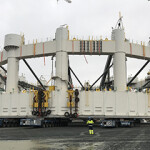Another huge sockeye run predicted for Alaska’s Bristol Bay

The Alaska Department of Fish and Game (ADFG) predicts over 51 million sockeye salmon will return to Bristol Bay in 2021, another massive run for Alaska’s most robust salmon fishery.
If the forecast holds, it will continue an unprecedented string of large runs in Bristol Bay, which have the fishery averaging over 48 million sockeye salmon annually for the past 10 years. The long-term contemporary average, calculated from 1963 to 2020, is 35.12 million fish. This season’s predicted run would be 45 percent greater than the 35.12 million mark.
ADFG predicts a harvest of 36.35 million fish, which would be 13 percent higher than the recent average of 32.23 million fish and 40 percent better than the long-term average of 21.88 million fish.
The report, authored by ADFG biologists Greg Buck, Jordan Head, and Stacy Vega, forecasts nearly half the fish will be age 1.2 sockeye, which means the fish have spent one year in freshwater and two years in saltwater. The bulk of the rest of the run would be 1.3 sockeye – meaning fish that have spent one year in freshwater and three in years in saltwater – coming in at 39 percent of the total. And while the larger 1.3 fish will be welcome, Tim Sands, the ADFG area manager for the Nushagak district, said the larger runs do seem to be returning smaller fish.
“There’s some indication that the fish size has been decreasing at age, so a 1.3 fish would be a bigger fish, but if there are lots of them we could have a smaller size of that age,” Sands told SeafoodSource.
The forecast predicts large, relatively evenly distributed runs across the four major districts. The Naknek-Kvichak district has the largest prediction at over 17 million fish, while the Nushagak district should see more than 15 million fish. The Egegik River system is forecast at over 11 million fish, and the Ugashik district is predicted to see a run of 6.66 million salmon.
If the fish are in fact spread out over the four districts, it is good news for fishermen and processors, as it helps prevent crowded grounds and slowdowns at processing plants. However, the report acknowledges predicting runs for individual river systems is tricky.
“Individual river forecasts have greater uncertainty compared to bay-wide forecasts. Over forecasting returns to some rivers while under forecasting returns to other rivers means that the overall Bristol Bay forecast is often more accurate than the forecast to any individual river,” the report said.
ADFG’s bay-wide forecasts since 2001 have turned in a mean absolute error of around 15 percent, according to the report, which puts the margin of error for the 2021 prediction between 38 million to 64 million fish. The upper end of the range would surpass the mark of the largest run ever, which was 62.3 million sockeye in 2018.
A year later, high prices combined with another strong run to give the fishery its most lucrative season ever at the docks, with an ex-vessel value of USD 306.5 million (EUR 258.7 million), far above the 20-year average of USD 124 million (EUR 104.7 million).
While the larger runs are likely the result of a combination of factors, Bristol Bay biologists believe that warmer temperatures in the region’s lakes are making the fish larger and stronger when they hit the ocean, decreasing mortality rates and bumping up run numbers.
Photo courtesy of Bristol Bay Regional Seafood Development Association






Share